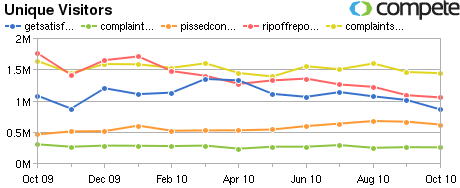Managing customer complaints in an online environment
Customer complaints can greatly affect the company brand and reputation, moreover since the Internet has increased its impact upon decision makers through being an easily accessible and transparent environment. Nowadays it is very simple to post online negative reviews regarding the products or / and services received.
Internet users express and voice their service experiences on online platforms, using even more complex sites than Twitter and Facebook, such as specialized complaint aggregators. These sites are search engine optimised, appearing high on Google Search results when a user either searches a brand name or a combination of terms such as [brand name] + complaints.
The specialized complaint aggregators have initially registered increased usage because they are easily accessible and people feel part of a community. With a high level of transparency, these sites can cause problems even to popular brands, challenging the PR and brand management teams. Sometimes, more brand damage can be done online than in a small article in a daily newspaper. For example, when Jeff Jarvis (author of What Would Google Do?) complained about the quality of Dell services and products, he got more than 700 comments to his post (Jarvis, 2005). Later on, this led to quality improvement initiatives for products and services offered by Dell.

However, the chart above indicates that the number of visitors has been declining in 2009, this being possible caused by several reasons:
- companies are listening to customer feedback and improving their products, services and processes
- better techniques and procedures for solving customer complaints, therefore removing the need for the customer to be more vocal about the complaint
- companies have increased their performance in managing their online reputation (Paternoster, 2010).
The chart only includes specialized complaint aggregators, without offering an analysis of complaints on other online platforms such as Twitter, Facebook and personal blogs.
Managing complaints in an online environment can be rather challenging. However, it can be done by having a brand management team and customer service to handle reputation issues that occur, including dealing with customer complaints.
Some Key Performance Indicators that can be very useful in measuring and managing customer complaints are:
- # Complaints received
- % First contact resolution rate
- # Compliments to complaints
- % Customer complaints due to poor service or product quality
- % Resolution excellence
- % Customer satisfaction with complaints handling
- % Willingness to recommend (smartKPIs.com, 2010).
Additionally a large number of Key Performance Indicator examples for Customer Service are available in the KPI examples section of smartKPIs.com.
References
- Paternoster, L. (2010), Managing your brand online: Dealing with complaints sites
- Jarvis, J. (2005), Dear Mr. Dell
Additional resources
Image Source:
- Complaint Reviews
- Paternoster (2010)

Tags: Customer Satisfaction, Jeff Jarvis, KPI, KPI in Practice






